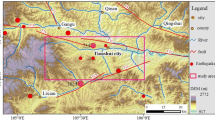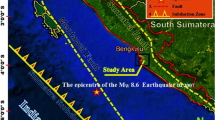Abstract
After a large-scale earthquake, the road is susceptible to get blocked by liquefaction or building collapse, and that results in disaster-relief difficulty. This study adopted two earthquake loss estimation systems in Taiwan, and the risk of road blockage caused by liquefaction or building collapse was calculated separately. A new modeling was proposed, and the comparisons of the results of a single factor and that of the joint factors were made. Four scenarios of peak ground acceleration (PGA) = 250, 400, 550, 750 Gal were tested. The result shows that the probability of road blockage due to liquefaction almost reaches the maximum when PGA hits 400 Gal. On the other hand, the probability of road blockage due to building collapse increases if PGA increases. The joint probability of road blockage due to liquefaction and building collapse can improve the underestimation when using either one factor, and it can evaluate the risk more realistically. At present, there is no risk assessment modeling considering two important factors for disaster-relief road planning in Taiwan. This study provides a simple and comprehensive disaster-relief road risk assessment modeling to make better emergency rescue plans. In addition, it can provide the information for conducting seismic strengthening policy for both sides of the disaster-relief road that can reduce the risk of obstacles to disaster-relief roads.
Similar content being viewed by others
References
Aguirre P, Vásquez J, de la Llera JC, González J, González G (2018) Earthquake damage assessment for deterministic scenarios in Iquique, Chile. Natural Hazards 92(3):1433–1461, DOI: https://doi.org/10.1007/s11069-018-3258-3
Anbazhagan P, Srinivas S, Chandran D (2012) Classification of road damage due to earthquakes. Natural Hazards 60:425–460, DOI: https://doi.org/10.1007/s11069-011-0025-0
Argyroudis S, Pitilakis K, Anastasiadis A (2005) Roadway network seismic risk analysis in urban areas: The case of Thessaloniki — Greece. Proceedings of international symposium of GEOLINE, May 23–25, Lyon, France
Argyroudis S, Selva J, Gehl P (2015) Systemic seismic risk assessment of road networks considering interactions with the built environment. Computer-Aided Civil and Infrastructure Engineering 30(7):524–540, DOI: https://doi.org/10.1111/mice.12136
Balijepalli C, Oppong O (2014) Measuring vulnerability of road network considering the extent of serviceability of critical road links in urban areas. Journal of Transport Geography 39:145–155, DOI: https://doi.org/10.1016/j.jtrangeo.2014.06.025
Boncio P, Liberi F, Caldarella M, Nurminen FC (2018) Width of surface rupture zone for thrust earthquakes: Implications for earthquake fault zoning. Natural Hazards and Earth System Sciences 18(1):241–256, DOI: https://doi.org/10.5194/nhess-18-241-2018
Bono F, Gutierrez E (2011) A network-based analysis of the impact of structural damage on urban accessibility following a disaster: The case of the seismically damaged Port Au Prince and Carrefour urban road networks. Journal of Transport Geography 19(6):1443–1455, DOI: https://doi.org/10.1016/j.jtrangeo.2011.08.002
British Columbia (2018) British Columbia disaster response transportation planning guide for road transportation. British Columbia Web, Retrieved August 29, 2019, https://www2.gov.bc.ca/assets/gov/driving-and-transportation/transportation-infrastructure/engineering-standards-and-guidelines/traffic-engineering-and-safety/disaster-response/disaster-response-transportation-planning.pdf
Caiado G, Oliveira C, Ferreira MA, Sa F (2012) Assessing urban road network seismic vulnerability: An integrated approach. Proceedings of 15th world conference on earthquake engineering, September 24–28, Lisbon, Portugal
Chan JL (2003) Study on the conflict of evacuation and rescue of emergency route in Taipei City — A case study of newly developed community (II). NSC91-2625-Z-305-001, National Science Council, Taipei, Taiwan (in Chinese)
Chang TW (2017) In the natural disasters — The awareness and new thinking of disaster prevention. The Magazine of The Chinese Institute of Civil and Hydraulic Engineering 44(2):26–34, DOI: https://doi.org/10.6653/MoCICHE/2017.04402.04 (in Chinese)
Chang SE, Nojima N (1998) Measuring lifeline system performance: Highway transportation systems in recent earthquakes. Proceedings of 6th U.S. national conference on earthquake engineering, May 31 — June 4, Seattle, WA, USA
Chen JS (2003) Establish vibration-induced damage model and mitigation system for urban roads (III). NSC91-2211-E-006-098, National Science Council, Taipei, Taiwan (in Chinese)
Chen CC, Chan JL (1999) On the effectiveness assessment of the emergency route in the urban areas. MIOIS 882006, Architecture and Building Research Institute, Ministry of the Interior, Taipei, Taiwan (in Chinese)
Chen LC, Chan SL, Hung HC (2004) On the assessment of the emergency network for the urban earthquake disaster. City and Planning 31(1):47–64 (in Chinese)
Chen YR Eguchi T (2003) Post-earthquake road unblocked reliability estimation based on an analysis of randomicity of traffic demands and road capacities. Proceedings of sixth U.S. conference and workshop on lifeline earthquake engineering, August 10–13, Long Beach, CA, USA, DOI: https://doi.org/10.1061/40687(2003)93
Chen NS, Hu GS, Deng MF, Zhou W, Yang CL, Han D, Deng JH (2011) Impact of earthquake on debris flows — A case study on the Wenchuan earthquake. Journal of Earthquake and Tsunami 5(5):493–508, DOI: https://doi.org/10.1142/S1793431111001212
Ertugay K, Argyroudis S, Sebnem Düzgün H (2016) Accessibility modeling in earthquake case considering road closure probabilities: A case study of health and shelter service accessibility in Thessaloniki, Greece. International Journal of Disaster Risk Reduction 17:49–66, DOI: https://doi.org/10.1016/j.ijdrr.2016.03.005
Federal Emergency Management Agency (2010) HAZUS-MH MR5 technical manual-earthquake model. Technical Manuals, Department of Homeland Security, Washington DC, USA
Fire and Disaster Management Agency (2006) Information about the Great Hanshin-Awaji Earthquake (final report). Fire and Disaster Management Agency Web, Retrieved August 29, 2019, http://www.fdma.go.jp/bn/1995/detail/941.html (in Japanese)
Fire and Disaster Management Agency (2019) Information about the Great East Japan Earthquake (No. 159). Fire and Disaster Management Agency Web, Retrieved August 29, 2019, https://www.fdma.go.jp/disaster/higashinihon/items/159.pdf (in Japanese)
Franchin P, Lupoi A, Pinto PE (2006) On the role of road networks in reducing human losses after earthquakes. Journal of Earthquake Engineering 10(2):195–206, DOI: https://doi.org/10.1080/13632460609350593
Giovinazzi S, Wilson T, Davis C, Bristow D, Gallagher M, Schofield A, Villemure M, Eidinger J, Tang A (2011) Lifelines performance and management following the 22 February 2011 Christchurch earthquake, New Zealand: Highlights of resilience. Bulletin of the New Zealand Society for Earthquake Engineering 44(4):402–417, DOI: https://doi.org/10.5459/bnzsee.44.4.402-417
Goretti A, Sarli V (2006) Road network and damaged buildings in urban areas: Short and long-term interaction. Bulletin of Earthquake Engineering 4(2):159–175, DOI: https://doi.org/10.1007/s10518-006-9004-3
Hadas Y, Rossi R, Gastaldi M, Pellegrino C, Zanini MA, Modena C (2015) Optimal critical infrastructure retrofitting model for evacuation planning. Transportation Research Procedia 10:714–724, DOI: https://doi.org/10.1016/j.trpro.2015.09.025
Hsu TP, Lu GH (2002) Development of the minimal risk routing model for post earthquake traffic management. Bullet of the College of Engineering, National Taiwan University 85:33–48 (in Chinese)
Ieda H, Kaminishi S, Inomata T, Suzuki T (1997) Street blockades in Hanshin earthquake’ 95 and its influence on disaster relief activities. Journal of Japan Society of Civil Engineering 576(IV-37):69–82, DOI: https://doi.org/10.2208/jscej.1997.576_69 (in Japanese)
Kuo CH, Lin CM, Huang JY, Hsu TY, Chao SH, Wen KL (2017) Strong ground motions and site amplifications in the near-source region of the 2016 Mw 6.5 Meinong Earthquake, Taiwan. NCREE Research Programs and Accomplishments, National Center for Research on Earthquake Engineering, National Applied Research Laboratories, Taipei, Taiwan (in Chinese)
Lee YT, Wang YJ, Chan CH, Ma KF (2017) The 2016 Meinong earthquake to TEM PSHA2015. Terrestrial, Atmospheric and Oceanic Sciences 28(5):703–713, DOI: https://doi.org/10.3319/TAO.2016.12.28.02
Lei TC, Chan WC, Lee BJ, Hsieh MH (2016) Risk assessment of road failures after earthquakes — An example of high socio-economic vulnerability region in Taichung City. Journal of City and Plan 43(1):59–87, DOI: https://doi.org/10.6128/CP.43.1.59 (in Chinese)
Liu SY, Wu CR, Le CY, Deng MC, Lee YN, Lee CS, Ke SS, Chien SW (2014) Scenario simulation for taipei metropolitan area II: Road, bridge, portable water, electricity, and important infrastructure-technical report. National Science and Technology Center for Disaster Reduction, New Taipei City, Taiwan (in Chinese)
Loh CH (1999) Summary report on the comprehensive survey of 921 Chi-Chi Earthquake. NCREE-99-033, National Center for Research on EarthquakeEngineering, National Applied Research Laboratories, Taipei, Taiwan (in Chinese)
Morbin R, Zanini MA, Pellegrino C, Zhang H, Modena C (2015) A probabilistic strategy for seismic assessment and FRP retrofitting of existing bridges. Bulletin of Earthquake Engineering 13(8):2411–2428, DOI: https://doi.org/10.1007/s10518-015-9725-2
Nolen-Hoeksema S, Morrow J (1991) A prospective study of depression and posttraumatic stress symptoms after a natural disaster: The 1989 Loma Prieta earthquake. Journal of Personality and Social Psychology 61(1):115–121, DOI: https://doi.org/10.1037/0022-3514.61.1.115
Ou JP, Li H (2011) The regional engineering damage and reconstruction strategy in Wenchuan earthquake of China. Journal of Earthquake Tsunami 5(2):189–216, DOI: https://doi.org/10.1142/S1793431111000929
Ozturk B (2010) Seismic microzonation studies and vulnerability assessment of existing buildings at nigde, Turkey. Proceedings of 14th European conference on earthquake engineering, August 30–September 3, Ohrid, North Macedonia Ozturk B (2011) Application of preliminary microzonation and seismic vulnerability assessment in a city of medium seismic risk in Turkey. Proceedings of 5th international conference on earthquake geotechnical engineering, January 10–13, Santiago, Chile
Pandit A, Biswal KC (2019) Prediction of earthquake magnitude using adaptive neuro fuzzy inference system. Earth Science Informatics 12(4):513–524, DOI: https://doi.org/10.1007/s12145-019-00397-w
Pirasteh S, Li J, Attarzadeh I (2015) Implementation of the damage index approach for the rapid evaluation of earthquake resistant buildings. Earth Science Informatics 8(4):751–758, DOI: https://doi.org/10.1007/s12145-014-0204-0
Pitilakis K, Argyroudis S, Kakderi K, Argyroudi A (2013) Systemic seismic vulnerability and risk analysis for buildings, lifeline networks and infrastructures safety gain. SYNER-G Synthetic Document, Joint Research Centre, European Commission, Brussels, Belgium, DOI: https://doi.org/10.2788/23242
Pitilakis KD, Kakderi KG (2011) Seismic risk assessment and management of lifelines, utilities and infrastructures. Proceedings of 5th international conference on earthquake geotechnical engineering, January 10–13, Santiago, Chile
Tokida K, Oda K, Nabeshima Y, Egawa Y (2007) Damage level of road infrastructure and road traffic performance in the mid Niigata prefecture earthquake of 2004. Structural Engineering/Earthquake Engineering 24(1):51–61, DOI: https://doi.org/10.2208/jsceseee.24.51s
Tokyo Disaster Management Council (2006) Estimated damage caused by future earthquakes occurring beneath Tokyo. Tokyo Disaster Management Council, Tokyo, Japan (in Japanese)
Toma-Danila D (2018) A GIS framework for evaluating the implications of urban road network failure due to earthquakes: Bucharest (Romania) case study. Natural Hazards 93(Suppl 1):97–111, DOI: https://doi.org/10.1007/s11069-017-3069-y
WGEEC (2013) The countermeasures due to the damages estimation of the earthquake beneath the capital. Working Group on Evaluation of the Earthquake beneath the Capital, Central Disaster Management Council, Retrieved August 29, 2019, http://www.bousai.go.jp/jishin/syuto/taisaku_wg/pdf/syuto_wg_siryo02.pdf (in Japanese)
Wu TH, Huang MW, Wu BR, Chen CY, Su CL, Lee CS, Ke SS (2014) Analysis of disaster potential, buildings, and casualty for the large-scale earthquake scenario in taipei metropolitan area-technical report. National Science and Technology Center for Disaster Reduction, New Taipei City, Taiwan (in Chinese)
Wu BR, Ke SS (2017) Application of a mesh-based earthquake impact assessment tool for water supply system on policy support. Proceedings of 10th JWWA/WRF/CTWWA water system seismic conference, October 18–19, Tainan, Taiwan
Wu YM, Teng TL, Shin TC, Hsiao NC (2003) Relationship between peak ground acceleration, peak ground velocity, and intensity in Taiwan. Bulletin of the Seismological Society of America 93(1):386–396, DOI: https://doi.org/10.1785/0120020097
Yeh CH (2003) Taiwan earthquake loss estimation system — TELES. Technical Report NCREE 03–002, National Center for Research on Earthquake Engineering, National Applied Research Laboratories, Taipei, Taiwan (in Chinese)
Yeh CH, Loh CH, Tsai KC (2006) Overview of Taiwan earthquake loss estimation system. Natural Hazards 37(1–2):23–37, DOI: https://doi.org/10.1007/s11069-005-4654-z
Acknowledgments
We would like to express our gratitude toward the NCDR for carrying out the assessment of TERIA, data, and technical reports.
Author information
Authors and Affiliations
Corresponding author
Rights and permissions
About this article
Cite this article
Lo, IT., Lin, CY., Yang, CT. et al. Assessing the Blockage Risk of Disaster-Relief Road for a Large-Scale Earthquake. KSCE J Civ Eng 24, 3820–3834 (2020). https://doi.org/10.1007/s12205-020-0340-7
Received:
Accepted:
Published:
Issue Date:
DOI: https://doi.org/10.1007/s12205-020-0340-7




